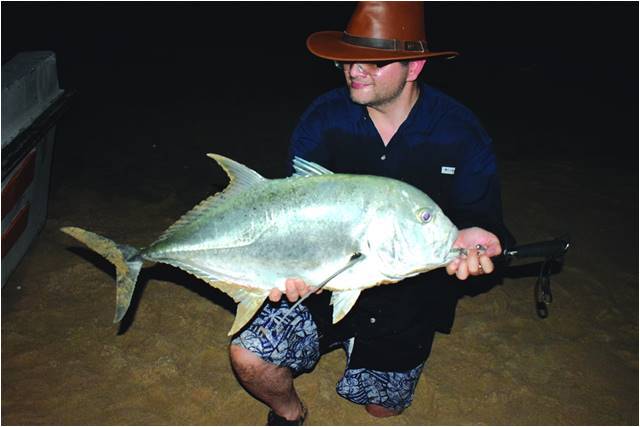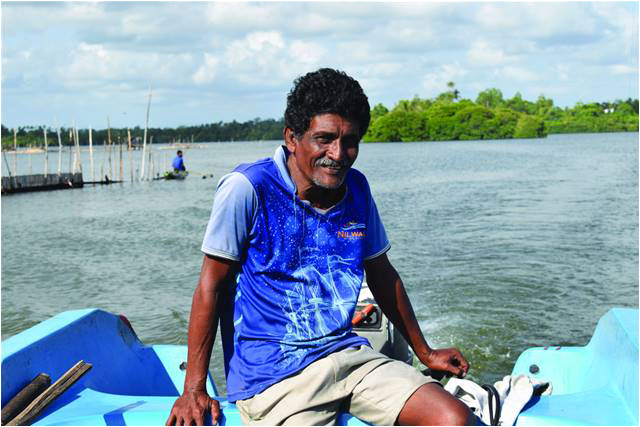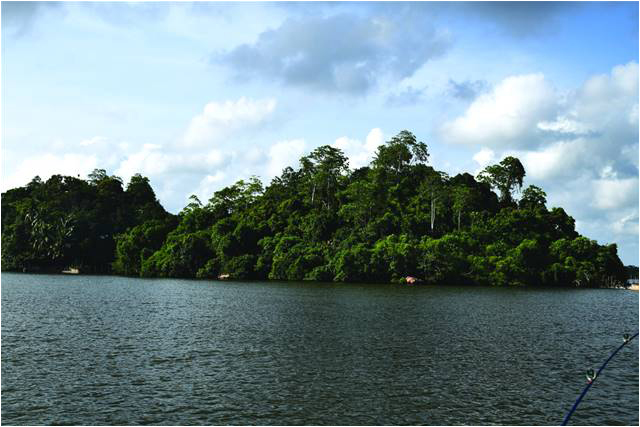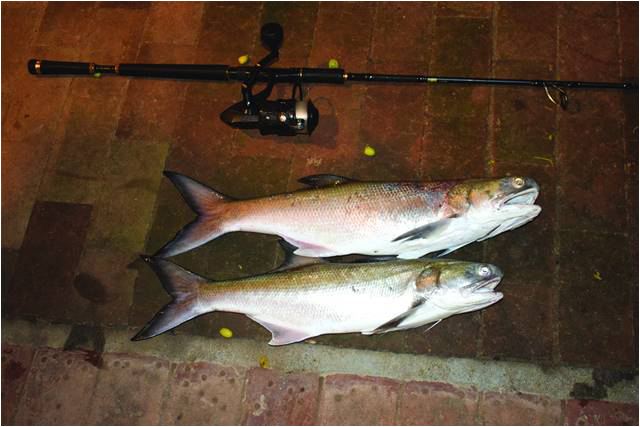
Traveling to get to a fishing destination is always something that I enjoy immensely. Whether it is the drive from Islamabad to Mangla Dam, the trek to reach a trout-lake high up in the wilds of Ghizer or embarking on an international jaunt from an airport, the excitement makes me feel like an eleven-year-old again. This trip would be taking me back to one of my favourite fishing grounds, The Resplendent Isle.
I reached a rain soaked, windy Colombo after making a fairly long journey from Islamabad via Muscat. The Sri Lankan Airlines flight from Lahore to Colombo which I usually take is yet to resume following its suspension due to the Pulwama-induced conflict that took place in February. Similarly the level of security in Colombo was far more stringent than usual due to the horrible terrorist attacks that occurred on Easter Sunday. To backtrack a bit, the landing in Colombo airport with its beautiful view of Negombo Lagoon and town seemed even more aesthetic than usual – given that I was flying in from Eastern Oman where not even a blade of grass grows naturally. The monsoon-drenched lushness of Ceylon comes as a shock to the senses.

Those of you who have read my book will know about Yakoob, my fishing buddy and the man who shamed me into learning how to catch barramundi. Our original plans for this trip had been to do some offshore trolling out of Trincomalee on the East Coast, which is unaffected by the Southwest Monsoon and has calm seas in the summer, and then head to the hill country to catch some mahseer and to see whether we can locate some of the rainbow trout that the British had introduced to the highland streams. The weather forecast, though, revealed that my trip coincided with a major monsoonal front which would lead to unprecedented rain and flooding with gale force winds in the interior sections of the island. Thus over the phone we decided to cancel the freshwater portion of our trip and concentrate on trolling the Bay of Bengal.
The next morning Yakoob came to the hotel to pick me up and off we went to Trincomalee. It was raining on and off throughout the long drive across the island and the clouds followed us east. Upon arriving at the Nilaveli Beach Hotel we were drenched by a thunderstorm. Rain during the summer months is rare on the semi-arid East Coast but the fact that the clouds were coming from the Arabian Sea across the island meant that the Bay of Bengal was calm.

After an early night I got up around nine. I was still slightly jet lagged following changing three time zones and not getting much sleep en-route. We went out to sea at noon, which Yakoob predicted to be the best time based on the prevailing winds, water temperature and tides. We trolled around for three hours with no luck and decided to head back in. Other than seeing a few flying fish gliding about, there was zero activity on the water. Once back I noticed lots of baitfish jumping about in the surf where it touched the shore.
After a shower to wash off the salt and a rest, we decided to do some shore casting close to dusk. I put together a barramundi outfit of a medium-heavy freshwater spinning rod and a Penn Fierce 5000 reel with 15 lb line and went to the beach where I tied on a golden colored rapala minnow and started casting. Within minutes I got a hit. This fish failed to connect but subsequently I hooked up to another one which I brought in - a small Giant Trevally (GT) of about a kilo. Yakoob came by and said he had just lost a similar fish. I returned to casting and got another hookup, this one fought very hard and I knew it was a better fish. I was worried that it would spool all the line off my reel. The members of the trevally family are very hard fighting fish. I remember the first time I caught a Jack Crevalle, the Atlantic version, in my university days in Miami, I thought I had hooked up to an alligator! This was indeed a better fish – a 4 kg GT came to shore and I was elated. That was going to be our dinner! It had completely mangled the hooks so I changed the trebles before resuming fishing. It had started to get dark when I got a huge hit and my rod bent over. This time it was a serious fish. After the fish had spooled over half the line from my reel I decided to tighten the drag and fight him in. Yakoob saw my bent rod and came over. I worked up a rhythm and would retrieve and run towards the water when the waves went out and walk backwards dragging the fish in as the waves came in. Completely soaked and worried the line would snap any minute, I finally beached the fish. It was a proper GT of 8 kg! After a photo session in the dark we headed in for a shower before returning to the beachside restaurant where the second fish showed up, baked to perfection.

The next morning’s offshore trolling was also uneventful. After breakfast we discussed our options. Offshore angling was not productive and we couldn’t head upcountry for freshwater fishing as the rains had intensified. It was even raining on the East Coast, so Yakoob called up a few of his local connections and we decided to fish a lagoon called Pullmodai about forty kilometers up the coast towards Mullaithivu. We arrived to find that our boatman was a shifty yet productive fellow named Nazeer, Over the next few days we had a lot of fun in Pullmodai catching everything from mangrove jack to GT but the real stars of the show were the threadfins. I caught my first ever threadfin while doing a fast troll out at the mouth where the lagoon meets the open sea and the next day Yakoob caught a wonderful specimen of 5 kg. In the evenings we would continue to fish the beach at Nilaveli and caught and released small GTs and kept a few migrating threadfins that we caught there as well.
On the way back to Colombo we stopped at the archaeological site of Polonnaruwa that I wanted to explore and document and crossed the town of Punanai, an infamous place home to a maneating leopard which was finally shot by a member of the Ceylon Civil Service back in the British days, the accounts of which are brilliantly documented in Christopher Ondaataje’s The Man-Eater of Punanai.
A trip to Sri Lanka for me is never complete without a day’s fishing in the Maadu Ganga. This beautiful wetland complex in the Southern Province just north of Ambalangoda is one of my favourite fishing destinations. The effects of the tourism slump following the Easter bombings were pronounced as a lack of tourists meant very few boats were about, which usually take tourists out to experience the lagoon and mangroves. The colourful boatman Dharambharam was complaining of how no tourists meant that a lack of tips was making it difficult to afford his evening arrack! The fishing was quite good though with the aggressive juvenile barracudas striking the lures almost as soon as they hit the water. The lush greenery of the Maadu Ganga is even more pronounced during the monsoon.
Soon enough it was time to head back home. As I went drove to the airport to catch my flight to Muscat, I hoped that the island heals from the aftermath of the bombings and that the tourists return. But not too many fisherman – I want to keep the fish for myself!
The author is the writer of ‘Asiatic Angling Adventures’, a travelogue on fishing and adventure travel across Asia, available at Saeed Book Bank, Islamabad and at Amazon.co.uk. Find the author on Twitter @FatehMulk
I reached a rain soaked, windy Colombo after making a fairly long journey from Islamabad via Muscat. The Sri Lankan Airlines flight from Lahore to Colombo which I usually take is yet to resume following its suspension due to the Pulwama-induced conflict that took place in February. Similarly the level of security in Colombo was far more stringent than usual due to the horrible terrorist attacks that occurred on Easter Sunday. To backtrack a bit, the landing in Colombo airport with its beautiful view of Negombo Lagoon and town seemed even more aesthetic than usual – given that I was flying in from Eastern Oman where not even a blade of grass grows naturally. The monsoon-drenched lushness of Ceylon comes as a shock to the senses.

Those of you who have read my book will know about Yakoob, my fishing buddy and the man who shamed me into learning how to catch barramundi. Our original plans for this trip had been to do some offshore trolling out of Trincomalee on the East Coast, which is unaffected by the Southwest Monsoon and has calm seas in the summer, and then head to the hill country to catch some mahseer and to see whether we can locate some of the rainbow trout that the British had introduced to the highland streams. The weather forecast, though, revealed that my trip coincided with a major monsoonal front which would lead to unprecedented rain and flooding with gale force winds in the interior sections of the island. Thus over the phone we decided to cancel the freshwater portion of our trip and concentrate on trolling the Bay of Bengal.
The next morning Yakoob came to the hotel to pick me up and off we went to Trincomalee. It was raining on and off throughout the long drive across the island and the clouds followed us east. Upon arriving at the Nilaveli Beach Hotel we were drenched by a thunderstorm. Rain during the summer months is rare on the semi-arid East Coast but the fact that the clouds were coming from the Arabian Sea across the island meant that the Bay of Bengal was calm.

After an early night I got up around nine. I was still slightly jet lagged following changing three time zones and not getting much sleep en-route. We went out to sea at noon, which Yakoob predicted to be the best time based on the prevailing winds, water temperature and tides. We trolled around for three hours with no luck and decided to head back in. Other than seeing a few flying fish gliding about, there was zero activity on the water. Once back I noticed lots of baitfish jumping about in the surf where it touched the shore.
After a shower to wash off the salt and a rest, we decided to do some shore casting close to dusk. I put together a barramundi outfit of a medium-heavy freshwater spinning rod and a Penn Fierce 5000 reel with 15 lb line and went to the beach where I tied on a golden colored rapala minnow and started casting. Within minutes I got a hit. This fish failed to connect but subsequently I hooked up to another one which I brought in - a small Giant Trevally (GT) of about a kilo. Yakoob came by and said he had just lost a similar fish. I returned to casting and got another hookup, this one fought very hard and I knew it was a better fish. I was worried that it would spool all the line off my reel. The members of the trevally family are very hard fighting fish. I remember the first time I caught a Jack Crevalle, the Atlantic version, in my university days in Miami, I thought I had hooked up to an alligator! This was indeed a better fish – a 4 kg GT came to shore and I was elated. That was going to be our dinner! It had completely mangled the hooks so I changed the trebles before resuming fishing. It had started to get dark when I got a huge hit and my rod bent over. This time it was a serious fish. After the fish had spooled over half the line from my reel I decided to tighten the drag and fight him in. Yakoob saw my bent rod and came over. I worked up a rhythm and would retrieve and run towards the water when the waves went out and walk backwards dragging the fish in as the waves came in. Completely soaked and worried the line would snap any minute, I finally beached the fish. It was a proper GT of 8 kg! After a photo session in the dark we headed in for a shower before returning to the beachside restaurant where the second fish showed up, baked to perfection.

The next morning’s offshore trolling was also uneventful. After breakfast we discussed our options. Offshore angling was not productive and we couldn’t head upcountry for freshwater fishing as the rains had intensified. It was even raining on the East Coast, so Yakoob called up a few of his local connections and we decided to fish a lagoon called Pullmodai about forty kilometers up the coast towards Mullaithivu. We arrived to find that our boatman was a shifty yet productive fellow named Nazeer, Over the next few days we had a lot of fun in Pullmodai catching everything from mangrove jack to GT but the real stars of the show were the threadfins. I caught my first ever threadfin while doing a fast troll out at the mouth where the lagoon meets the open sea and the next day Yakoob caught a wonderful specimen of 5 kg. In the evenings we would continue to fish the beach at Nilaveli and caught and released small GTs and kept a few migrating threadfins that we caught there as well.
On the way back to Colombo we stopped at the archaeological site of Polonnaruwa that I wanted to explore and document and crossed the town of Punanai, an infamous place home to a maneating leopard which was finally shot by a member of the Ceylon Civil Service back in the British days, the accounts of which are brilliantly documented in Christopher Ondaataje’s The Man-Eater of Punanai.
A trip to Sri Lanka for me is never complete without a day’s fishing in the Maadu Ganga. This beautiful wetland complex in the Southern Province just north of Ambalangoda is one of my favourite fishing destinations. The effects of the tourism slump following the Easter bombings were pronounced as a lack of tourists meant very few boats were about, which usually take tourists out to experience the lagoon and mangroves. The colourful boatman Dharambharam was complaining of how no tourists meant that a lack of tips was making it difficult to afford his evening arrack! The fishing was quite good though with the aggressive juvenile barracudas striking the lures almost as soon as they hit the water. The lush greenery of the Maadu Ganga is even more pronounced during the monsoon.
Soon enough it was time to head back home. As I went drove to the airport to catch my flight to Muscat, I hoped that the island heals from the aftermath of the bombings and that the tourists return. But not too many fisherman – I want to keep the fish for myself!
The author is the writer of ‘Asiatic Angling Adventures’, a travelogue on fishing and adventure travel across Asia, available at Saeed Book Bank, Islamabad and at Amazon.co.uk. Find the author on Twitter @FatehMulk

